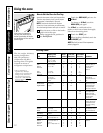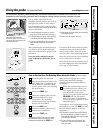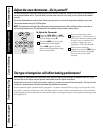
20
Consumer Support Troubleshooting Tips Care and Cleaning Operating Instructions Safety Instructions
Using the convection oven.
How to Set the Oven for Convection Roasting when Using the Probe
The display will flash PROBE and the
oven control will signal if the probe is
inserted into the outlet, and you have not
set a probe temperature and pressed the
START pad.
Place the rack in the lowest position
(A). Insert the probe into the meat.
Plug the probe into the outlet in the
oven. Make sure it is pushed all the
way in. Close the oven door.
Touch the CONVECTION ROAST pad.
Touch the number pads to set the
desired oven temperature.
Touch the PROBE pad.
Touch the number pads to set the
desired internal meat temperature.
Touch the START pad.
When the oven starts to heat, the word
LO will be in the display.
After the internal temperature of the meat
reaches 100°F, the changing internal
temperature will be shown in the display.
When the internal temperature of
the meat reaches the number you
have set, the probe and the oven
turn off and the oven control
signals. To stop the signal, touch the
CLEAR/OFF pad. Use hot pads to
remove the probe from the food.
Do not use tongs to pull on it—they
might damage it.
CAUTION: To prevent possible burns,
do not unplug the probe from the oven outlet until
the oven has cooled. Do not store the probe in
the oven.
NOTE:
■ If the probe is removed from the food before
the final temperature is reached, a tone will
sound and the display will flash until the probe
is removed from the oven.
■ You will hear a fan while cooking with this
feature. The fan will stop when the door is
opened, but the heat will not turn off.
■ You can use the timer even though you cannot
use timed oven operations.
For best results when roasting large
turkeys and roasts, we recommend
using the probe included in the
convection oven.
To change the oven temperature
during the Convection Roast cycle,
touch the CONVECTION ROAST pad
and then touch the number pads to
set the new desired temperature.
Convection Roasting Guide
Meats Minutes/Lb. Oven Temp. Internal Temp.
Beef Rib, Boneless Rib, Rare 20–24 325°F 140°F†
Top Sirloin Medium 24–28 325°F 160°F
(3 to 5 lbs.) Well 28–32 325°F 170°F
Beef Tenderloin Rare 10–14 325°F 140°F†
Medium 14–18 325°F 160°F
Pork Bone-In, Boneless (3 to 5 lbs.) 23–27 325°F 170°F
Chops (1/2 to 1″ thick) 2 chops 30–35 total 325°F 170°F
4 chops 35–40 total 325°F 170°F
6 chops 40–45 total 325°F 170°F
Ham Canned, Butt, Shank (3 to 5 lbs. fully cooked) 14–18 325°F 140°F
Lamb Bone-In, Boneless (3 to 5 lbs.) Medium 17–20 325°F 160°F
Well 20–24 325°F 170°F
Seafood Fish, Whole (3 to 5 lbs.) 30–40 total 400°F
Lobster Tails (6 to 8 oz. each) 20–25 total 350°F
Poultry Whole Chicken (2
1
⁄2 to 3
1
⁄2 lbs.) 24–26 350°F 180°–185°F
Cornish Hens, Unstuffed (1 to 1
1
⁄2 lbs.) 50–55 total 350°F 180°–185°F
Stuffed (1 to 1
1
⁄2 lbs.) 55–60 total 350°F 180°–185°F
Duckling (4 to 5 lbs.) 24–26 325°F 180°–185°F
Turkey, Whole*
Unstuffed (10 to 16 lbs.) 8–11 325°F 180°–185°F
Unstuffed (18 to 24 lbs.) 7–10 325°F 180°–185°F
Turkey Breast (4 to 6 lbs.) 16–19 325°F 170°F
* Stuffed birds generally require 30–45 minutes additional roasting time. Shield legs and breast with foil to prevent
overbrowning and drying of skin.
† The U.S. Department of Agriculture says “Rare beef is popular, but you should know that cooking it to only 140°F means
some food poisoning organisms may survive.” (Source: Safe Food Book. Your Kitchen Guide. USDA Rev. June 1985.)


















